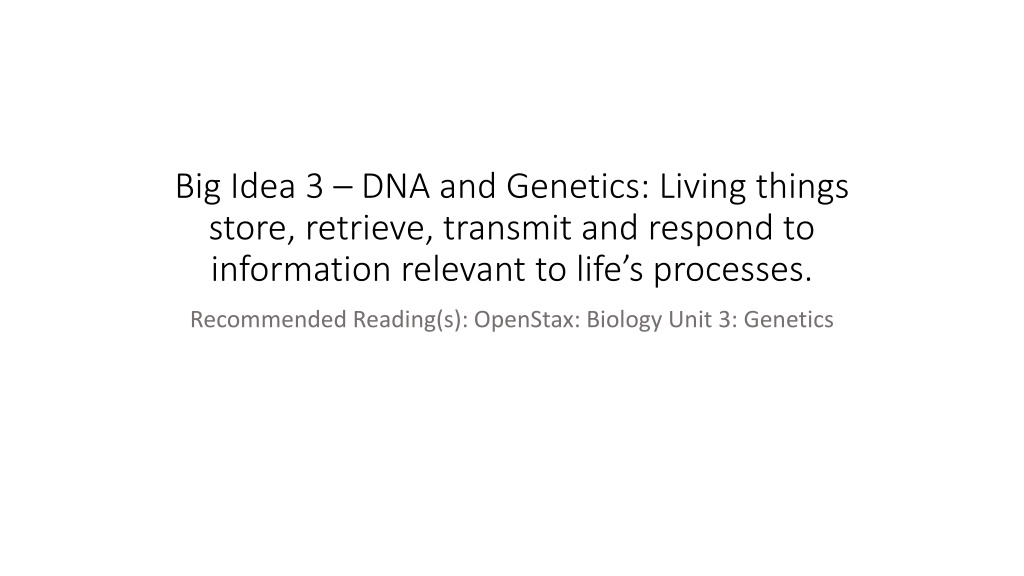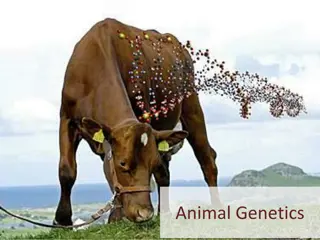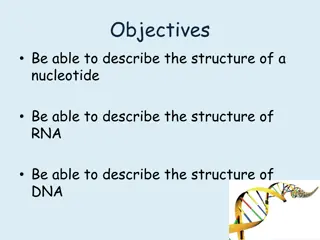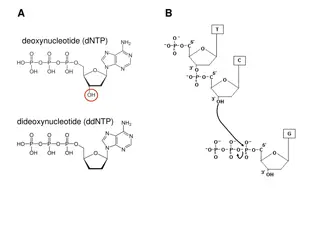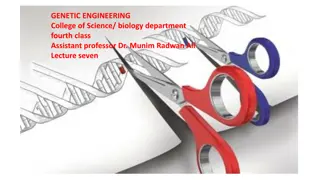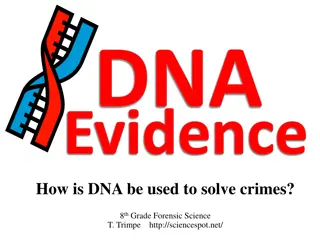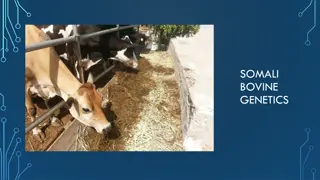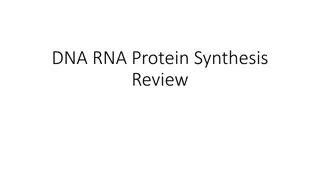Understanding DNA and Genetics: A Comprehensive Overview
Living things store, retrieve, transmit, and respond to information essential for life processes. This encompasses the heritability of genetic traits through DNA and RNA, the discovery of the double helix structure of DNA, and key experiments validating DNA as the heritable molecule. Explore the composition and functions of DNA and RNA, chromosome representation in Eukaryotes, and the building blocks of DNA molecules.
Download Presentation

Please find below an Image/Link to download the presentation.
The content on the website is provided AS IS for your information and personal use only. It may not be sold, licensed, or shared on other websites without obtaining consent from the author. Download presentation by click this link. If you encounter any issues during the download, it is possible that the publisher has removed the file from their server.
E N D
Presentation Transcript
Big Idea 3 DNA and Genetics: Living things store, retrieve, transmit and respond to information relevant to life s processes. Recommended Reading(s): OpenStax: Biology Unit 3: Genetics
Enduring Understanding 3.A: Heritable information provides for continuity of life. Chapter 14 and 15 of OpenStax Textbook
DNA and RNA 3.A.1: DNA, and in some cases RNA, is the primary source of heritable information. Genetic traits are inherited from one generation to the next through DNA and, in some cases, RNA. Different structures inside of cells contain their own DNA or RNA like plasmids (mitochondria and chloroplasts are examples of this). In Eukaryotes (cells contain membrane-bound organelles) Multiple, linear chromosomes In Prokaryotes (cells don t contain membrane-bound organelles) Singular, circular chromosomes
Proof of DNA as Heritable Molecule Look up the experiment summarize its significance how do they relate to DNA or heredity? Watson, Crick, Wilkins, and Franklin on DNA structure. Discovered double helix structure of DNA. Avery-Macleod McCarty Experiments evidence for transfer of DNA between bacteria through infecting mice. Hershey-Chase Experiment bacteriophage laced with radioactive materials to proteins. Shifted thinking from idea proteins held genetic information, not DNA.
DNA DNA: RNA: Composed of sugar, phosphate and nitrogenous bases Four (five) different types of bases: __________ (__________ for RNA), __________, __________, __________
DNA DNA: deoxyribonucleic acid RNA: ribonucleic acid Composed of sugar, phosphate and nitrogenous bases Four (five) different types of bases: Thymine (Uracil for RNA), Cytosine, Adenine, Guanine
DNA (In Eukaryotes) Each strand of DNA represents a chromosome! Double-helix structure of DNA supercoils (bends and winds in many ways). This allows it to condense into a very small area.
DNA Build a DNA molecule activity. Purines: A, G Pyrimidines: C,T, U C always goes with G A always goes with T (Unless it is RNA in which case A goes with U)
DNA Structure and Replication DNA replicates itself when new cells are made! It s another complicated biological process!
DNA Structure and Replication Crash Course Primase, Ligase, Helicase, DNA Polymerase Are a series of enzymes that are coordinated to allow for DNA replication to occur. When DNA is being replicated there is a leading strand and a lagging strand [which takes longer to make and is done so in fragments (okazaki)] DNA (nucleotides) is made up of a sugar group, a phosphate group, and one of four different nitrogenous bases (A,T,C,G).
Protein Synthesis Recommended Reading (s): 15.3, 15.4, 15.5 in OpenStax: AP Biology Recommended Video: Crash Course Biology #11; Bozeman Science: Transcription and Translation
Protein Synthesis from DNA Vocab mRNA tRNA rRNA Helicase DNA Polymerase RNA Polymerase Codon
Protein Synthesis Vocab mRNA messenger RNA (carries messages from nucleus) tRNA transfer RNA (transfers amino acids to ribosome) rRNA what ribosomes are mostly composed of allows mRNA to fit into it. Helicase DNA-splitting enzyme DNA Polymerase creates new DNA strands RNA Polymerase creates RNA strands (like mRNA) Codon three-nucleotide code for a particular amino acid.
Protein Synthesis __________ ___________ ___________ Replication creates new copies of DNA (perhaps to create a new cell). DNA Polymerase reads and creates a new strand of DNA from an unzipped DNA. Transcription takes the information encoded in DNA and encodes it into mRNA, which heads out of the cell's nucleus and into the cytoplasm. During translation, the mRNA works with a ribosome and tRNA to synthesize proteins.
Protein Synthesis Replication Transcription Translation Replication creates new copies of DNA (perhaps to create a new cell). DNA Polymerase reads and creates a new strand of DNA from an unzipped DNA. Transcription takes the information encoded in DNA and encodes it into mRNA, which heads out of the cell's nucleus and into the cytoplasm. During translation, the mRNA works with a ribosome and tRNA to synthesize proteins.
Transcription Transcription (creation of a transcript of DNA information) Helicase (an enzyme), unzips the DNA inside the nucleus. DNA or RNA Polymerase (other enzymes), binds to the DNA and rides along it, adding complementary base pairs until it reaches a stop. This complementary new strand (for RNA Polymerase) is called mRNA or messenger RNA and will exit the nucleus. Remember: In RNA, Thymine = Uracil (Why? It s less energy-intensive than Thymine and makes it easier to create) The mRNA then ventures from the nucleus to a ribosome in the cell s cytoplasm BUT FIRST!
mRNA is still a molecule, therefore it is able to react with molecules it may encounter on the way to the ribosome that s why this occurs, to chemically protect it. mRNA modification Prior to the mRNA leaving the nucleus it needs to be ___________and___________ through capping and the addition of a tail. 5 Capping occurs - 3 Poly-A Tail - Pre-mRNA splicing also occurs (or excision of introns). There s basically filler parts of the DNA that get cut out in the transcription process.
mRNA is still a molecule, therefore it is able to react with molecules it may encounter on the way to the ribosome that s why capping/tailing occurs, to chemically protect it. mRNA modification Prior to the mRNA leaving the nucleus it needs to be prepared and protected through capping and the addition of a tail. 5 Capping occurs - The five prime end gets a 7-methylguanosine cap through phosphorylation. This helps initiate its reading at a ribosome. 3 Poly-A Tail - an enzyme, poly-A polymerase, adds about 200 adenines that protect the other side of the strand. Pre-mRNA splicing also occurs (or excision of introns). There s basically filler parts of the DNA that get cut out in the transcription process.
Translation Translation (translation of mRNA into a combination of amino acids polypeptide chain): The mRNA meets with a corresponding ribosome and awaits a tRNA (transfer RNA which transfers amino acids) to bond with/compliment its code (example: if the mRNA is CAG, the tRNA would be GUC). The code, or codon, is a sequence of three DNA or RNA nucleotides that corresponds with a specific amino acid or stop signal during protein synthesis. When bonded with the mRNA in the ribosome, it allows a certain amino acid to be added to the chain (the amino acid provided corresponds to the code). Note: certain amino acids are considered start codons amino acids which will start the amino acid, and some are called stop codons which will end the amino acid chain.
(1) The DNA transcribes its message into mRNA in the nucleus (2) mRNA leaves the nucleus A U G U A U C G A U C G U DNA (3) The mRNA moves to find the appropriate ribosome. mRNA (8) The released amino acids bond together to form a protein. nucleus (7) The exposed codon of the tRNA matches with exposed bases of the template, which causes the tRNA to release the amino acid. The free tRNA returns to get another amino acid cytoplasm AA1 AA4 AA2 (5) The tRNA found in the cytoplasm finds its specific amino acid (AA) (6) The tRNA carries the amino acid over to the ribosome AA2 AA1 C A U A U G U A U C G A U C G U A U C tRNA G A C AA1 ribosome AA2 (9) When the protein is finished the mRNA and ribosome disassemble so that the ribosome is free to be a protein synthesis site again. The mRNA may return to the nucleus to be broken apart to form more mRNA AA3 (4) The mRNA attaches to the ribosome to make a template A U G
Protein Sequencing Practice What codes for what? Each three-letter codon codes for an amino acid. These amino acids are assembled at a ribosome to make a protein. mRNA = the type of amino acids combined to make a protein.
Different types of codons Different amino acids may be start or stop codons. Therefore, if damage happened to the DNA (or mRNA), the wrong amino acid may be brought, the wrong protein made, and a large, useless organic molecule may be created. DNA has a proofreading system to cope with this in addition to the complimentary base pairing!
Differences in translation and transcription in Prokaryotes versus Eukaryotes Create a chart including three major differences between each (I d recommend using your OpenStax textbook). Eukaryote (cell has a membrane-bound nucleus) Prokaryote (cell doesn t have a membrane-bound nucleus)
Differences in translation and transcription in Prokaryotes versus Eukaryotes Create a chart including three major differences between each (I d recommend using your OpenStax textbook). Eukaryote (cell has a membrane-bound nucleus) 3 Types of RNA Polymerase Prokaryote (cell doesn t have a membrane-bound nucleus) Only has one type of RNA Polymerase Transcription and Translation occur simultaneously in the cytoplasm. Transcript (Nucleus) Translation (Cytoplasm) Rate of replication is 50 nucleotides/second Rate of replication is 500 nucleotides/second
Differences in translation and transcription in Prokaryotes versus Eukaryotes Create a chart including three major differences between each (I d recommend using your OpenStax textbook). Eukaryote (cell has a membrane-bound nucleus) Have linear DNA in the form of chromosomes Prokaryote (cell doesn t have a membrane-bound nucleus) Have circular DNA (like plastids) Prokaryotes are smaller than eukaryotes and their DNA is similarly smaller. Eukaryotes mRNA codes for one protein at a time. Transcription occurs inside nucleus, translation occurs in cytoplasm Transcription and translation occur simultaneously.
Proteins and Gene Expression The proteins that are created in translation ultimately reflect what we see in the phenotype (visible, observable traits or content) of organisms. Translation can ultimately - - Translation can be triggered by the presence of molecules in organisms or cells this is called gene expression (we ll come back to this).
Proteins and Gene Expression The proteins that are created in translation ultimately reflect what we see in the phenotype (visible, observable traits or content) of organisms. Translation can ultimately - code for enzymes associated with digestion or catalyzing of biological processes/reactions. - synthesize proteins that are structural components in the body (melanin, keratin). Translation can be triggered by the presence of molecules in organisms or cells this is called gene expression (we ll come back to this).
Biotechnologies applying this knowledge Genetic Engineering can modify DNA or RNA in organisms. - - - - - -
Biotechnologies applying this knowledge Genetic Engineering can modify DNA or RNA in organisms. - CRISPR - PCR (Polymerase Chain Reaction) - GMOs - Transgenic organisms - Cloned animals - Pharmaceuticals (such as human insulin).
Study/Learning Resource Feel free to take a notes package that summarizes a big part of this topic thus far. Expect a quiz next class applying this content.
